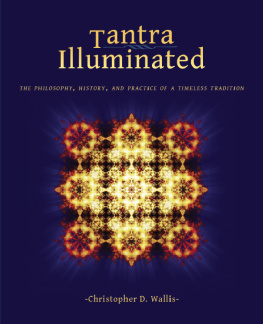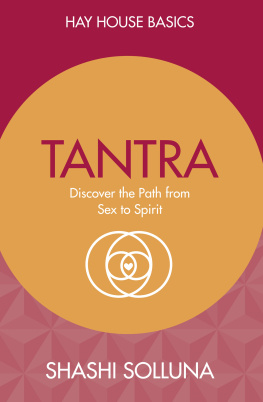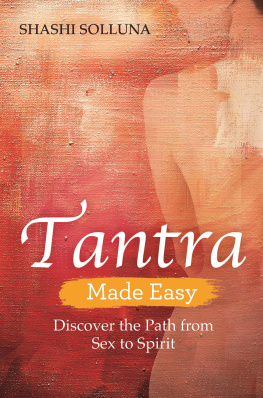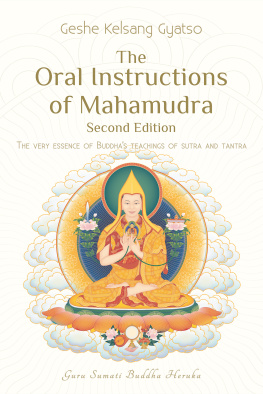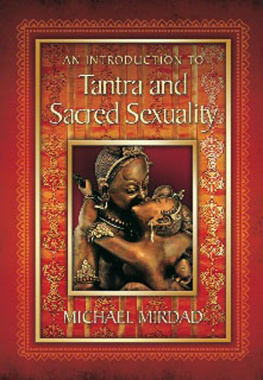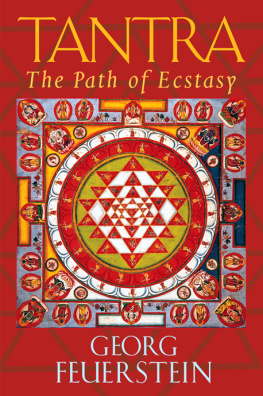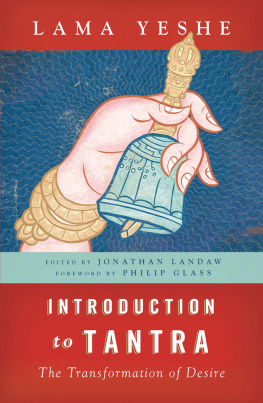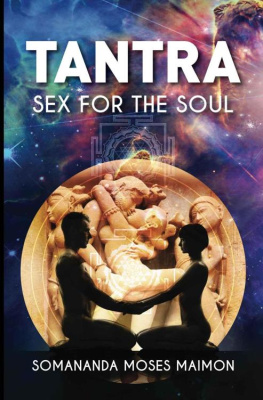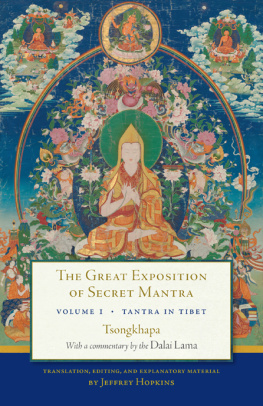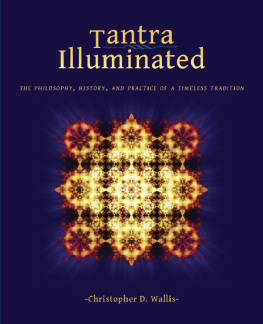T antra
Illuminated
the philosophy, history, and
practice of a timeless tradition

Second Edition
-Christopher D. Wallis-
with illustrations by Ekabhmi Ellik

Mattamayra Press
Mattamayra Press
369B Third St #454
San Rafael, CA 94901
(510) 815-9642
mattamayura.org
Tantra Illuminated
The Philosophy, History, and Practice of a Timeless Tradition
Text Christopher D. Wallis
Illustrations Ekabhmi Ellik
Second edition 2013
First edition 2012
Cover Art: Greg R. Perkins
eBook Design: Franklin Veaux
Copyediting: Margaret Bendet and Anne Malcolm
Illustrations: Ekabhmi Ellik
Managing Editor: Eve Rickert
Ebook edition v1.1
All rights reserved, No part of the book may be used or reproduced in any manner whatsoever without written permission except in the case of brief quotations in critical articles and reviews.
Publishers Cataloging-In-Publication Data
(Prepared by The Donohue Group, Inc.)
Wallis, Christopher D.
Tantra illuminated : the philosophy, history, and practice of a timeless tradition / Christopher D. Wallis ; with illustrations by Ekabhmi Ellik. -- 2nd ed.
p. : ill. ; cm.
First edition published in 2012.
Includes translations from primary Sanskrit sources.
Includes bibliographical references and index.
ISBN: 978-0-9897613-0-7 (pbk.)
ISBN: 978-0-9897613-1-4 (hardcover)
1. Saivism. 2. Tantrism. I. Ellik, Ekabhmi. II. Title.
BL1280.54 .W35 2013
294.5/513 2013946524
dedication and benediction
Namas te , reverent greetings to you.
Reverent greetings to the One who dwells within you, as you.
Reverent greetings to the divine Light of Consciousness that manifests as this entire universe of tangible and intangible things; that makes all experience possible; and that shines forth in the form of true wisdom, the spontaneously blissful intuition of its own self-luminous nature.
May all apparent obstacles to the unfolding of our path and the completion of this work be dissolved through the realization that they are not separate from Consciousnessthat they are the Path, and they are the Work.
May diving into the nectarean ocean of the Tantrik teachings support you in the journey to awareness of your own true nature, joyously raising you far beyond what your mind ever thought possible for you, into a whole new expansive world of wonder.
Knowing your own Self, may you shine the light of that sublime Awareness out to include all beings. May you thus become a manifestation of divine grace in this world for the benefit of all beings.
This book is dedicated to You.
May all beings be free! May all beings be free! May all beings be free!
Hari O Tat Sat
nondual invocation
to the divine
tm tva Girij mati sahacar pr arra gham
Pj te viayopabhoga-racan nidr samdhi-sthiti |
Sacra padayo pradakia-vidhi stotri sarv gira
Yad-yat karma karomi tat-tad-akhila ambho tavrdhanam ||
tm tvam | You are my Self, my core, my essence. |
Girij mati | The Goddess is my mind. |
sahacar pr | My pras are Your attendants. |
arra gham | My body is Your temple. |
pj te viayopabhoga- | Enjoying the objects of the senses is |
racan | my worship of You. |
nidr samdhi-sthiti | My sleep is Your state of samdhi. |
Sacra padayo | Wherever I walk, |
pradakia-vidhi | I am performing pradakia of You. |
stotri sarv gira | All my words are hymns of praise to You. |
Yad-yat karma karomi | Whatever actions I perform, |
tat-tad-akhila | they are all worship of You, |
ambho tavrdhanam | O Benevolent One! |
Jaya jaya Karubdhe r Mahdeva ambho!
Hail! Hail! O ocean of compassion! O reverend Great Divinity! O Benevolent Lord!
preface
uniqueness of the present volume
The book you hold in your hands is the first of its kind. That is, it is the first introduction to the history of Tantra and its philosophy written for a general audience. The present volume is unique in combining these three characteristics: 1) it is intended for a readership other than professional scholars, that is, both spiritual practitioners ( yog s) and undergraduate students; 2) it provides a thorough overview of classical Tantra (8 th th centuries); and 3) it is based on the original manuscript sources in Sanskrit and the best of the scholarship produced over the last thirty years, especially the major research breakthroughs in Tantrik studies in the last ten years.
need for this book
This book meets a specific need, for outside of a relatively small circle of scholars, awareness of the huge impact of the Tantrik religions on the development of Asian spiritual thought is still virtually unknown. In university courses on Indian religion, it is either not taught, or it is touched on briefly in a grossly distorted manner. And in countless popular books like the recent American Veda, doctrines that come out of Tantra are mistakenly identified as belonging to other streams of Indian religion. A book for the wider readership is needed to set the record straight, give credit where credit is due, and provide accurate answers to the many questions that the more thoughtful practitioners of modern yoga are starting to ask about the real Tantra.
the purpose of this book
The purpose of this book is to clearly and effectively answer the following questions:
What is Tantra?
What are its basic spiritual and philosophical ideas?
What is its history and who are its main figures?
What are its fundamental practices?
What is the significance of Tantra to the broader history of Indian yoga?
To what extent is it possible to incorporate Tantrik teachings and practices into a modern Western yoga practice?
The book has an additional purpose as wellto offer the reader an immersion into a spiritual worldview that (if she chooses to work with it deeply) can trigger radical personal transformation and permanently expanded awareness.
scope of the present volume
You may wonder what the phrase classical Tantra refers to. It distinguishes our subject matter from the later Hindu Tantra and haha-yoga traditions, and also from modern Western neo-Tantra. The classical Tantra treated in this volume is associated with a specific religious tradition, the religion of iva-akti, also known as Shaivism, the dominant religion of India in the medieval period. But there is also the important category of Buddhist Tantra; thus some readers will wish to know its relation to what I am calling classical Tantra. (If you are not interested in this question, please skip to How to read this book, below.) To answer the question briefly (since more detail is given later on), I believe that this book is a good introduction to Tantra, even for those interested in its Buddhist form, because the latter is so very similar to classical iva-akti Tantra. This is not coincidental; the practices of Buddhist Tantra that are not found in earlier (non-Tantrik) Buddhism were directly adopted from classical iva-akti Tantra. Though we dont know with certainty the direction of influence between nondual iva-akti Tantra and the teachings of Dzogchen, this book, though it focuses on aiva (= iva-akti) Tantra, can indeed function as an adequate orientation to Tantra in general, i.e., to the worldview and practices shared by the various Tantrik religions.
Next page
